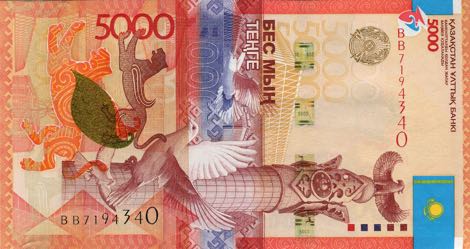Kazakhstan
Kazakhstan new 500-tenge note (B148a) confirmed
27 11, 2017 10:29 Category: Central Asia
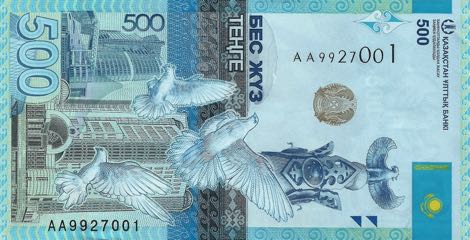
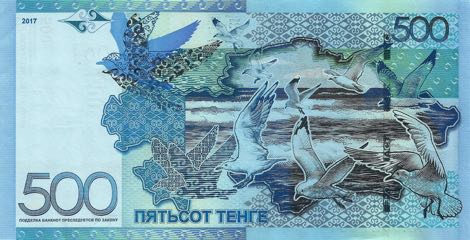
Like B147, but revised front/back, reduced in size, and new date (2017). Prefix AA. Intro: 22.11.2017.
Russian press release.
Courtesy of Wonsik Kang, Arsentij Khonin, Ömer Yalçinkaya, and Albert Vokhmin.
Kazakhstan new no-signature 5,000-tenge note (B149) confirmed
21 11, 2017 20:06 Category: Central Asia

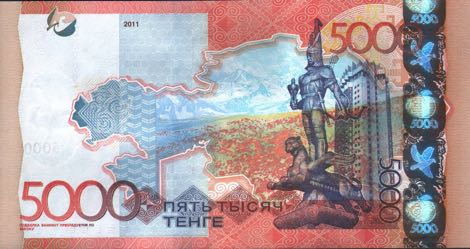
Like B139b, but no signature at upper left back. Prefix BЛ.
Courtesy of Denis Orlov and Arsentij Khonin.
Kazakhstan new no-signature 500-tenge note (B147a) confirmed
10 08, 2017 09:42 Category: Central Asia
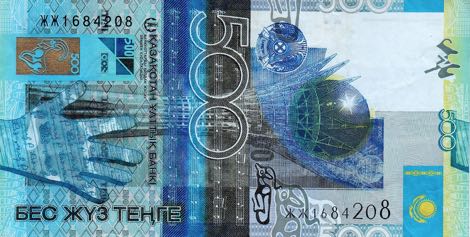
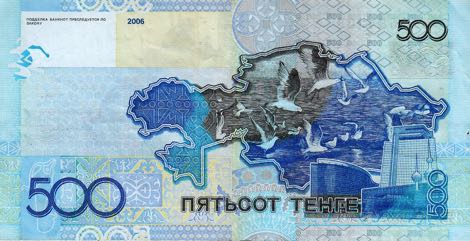
Like B129, but no signature, and changes to bank name.
Courtesy of Said Chelmouni, Denis Orlov, Arsentiy Khonin, and Ömer Yalçinkaya.
Kazakhstan new 1,000-tenge note (B146a) confirmed
29 11, 2016 07:07 Category: Central Asia


B146: Like B143, but without signature, and other minor modifications to the appearance of the bank’s name on front/back.
Courtesy of Ömer Yalçinkaya (eBay store
Kazakhstan new 10,000-tenge commemorative note (B145a) confirmed
12 12, 2016 08:11 Category: Central Asia
According to a press release dated 15 November 2016, to commemorate the 25th anniversary of independence, on 1 December 2016 the National Bank of Kazakhstan introduced a note featuring the portrait of the country's first, and so far only president, Nursultan Äbishuly Nazarbayev.
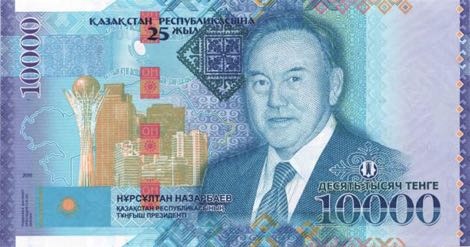
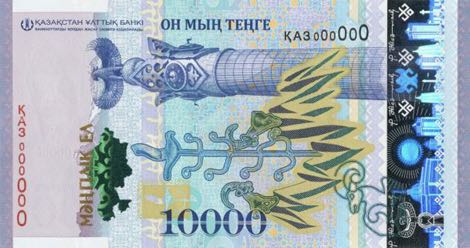
B145 (PNL): 10,000 tenge (US$30)
Violet and blue. Front: Outline of Kazakhstan; flag; Astana-Baiterek monument and large buildings in Astana; President Nursultan Äbishuly Nazarbayev wearing suit and tie; national emblem. Back (vertical): Mountain range; outline of Kazakhstan in SPARK; Kazakh Eli monument in Astana. Holographic stripe with demetalized signature of President Nursultan Abishuly Nazarbayev, Kazakh Eli monument, and Astana skyline. Solid security thread. Windowed security thread with demetalized sun and OH. Watermark: Nursultan Äbishuly Nazarbayev with electrotype 10000. Printer: (BFoNBK). 149 x 79 mm.
a. 2016. No signature. Prefix AA. Intro: 01.12.2016.
Courtesy of Ömer Yalçinkaya (eBay store ), Albert Vokhmin, Cleo Phas, Nosenko Igor, and Mark Irwin.
), Albert Vokhmin, Cleo Phas, Nosenko Igor, and Mark Irwin.


B145 (PNL): 10,000 tenge (US$30)
Violet and blue. Front: Outline of Kazakhstan; flag; Astana-Baiterek monument and large buildings in Astana; President Nursultan Äbishuly Nazarbayev wearing suit and tie; national emblem. Back (vertical): Mountain range; outline of Kazakhstan in SPARK; Kazakh Eli monument in Astana. Holographic stripe with demetalized signature of President Nursultan Abishuly Nazarbayev, Kazakh Eli monument, and Astana skyline. Solid security thread. Windowed security thread with demetalized sun and OH. Watermark: Nursultan Äbishuly Nazarbayev with electrotype 10000. Printer: (BFoNBK). 149 x 79 mm.
a. 2016. No signature. Prefix AA. Intro: 01.12.2016.
Courtesy of Ömer Yalçinkaya (eBay store
Press release: The Banknote Register 2nd edition
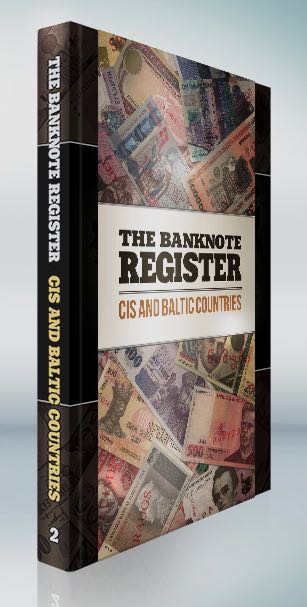
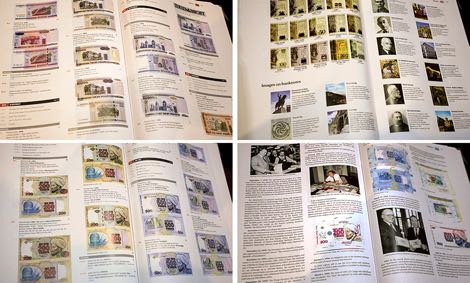
The Banknote Register: CIS and Baltic Countries
1991-2016, General Issues
Second edition (English)
Author: Dmitry Zagorenko (IBNS #11608, General Secretary of the Russian Chapter of IBNS).
Editor: Dmitry Litvak (IBNS LM #204, President of the Russian Chapter of IBNS).
Format: A4. Weight: 1,5 Kg.
Hard cover with pressed gilding and book jacket band.
344 full-color pages (paper 115 g/m2).
16 Chapters (Russia, Ukraine, Belarus, Uzbekistan, Kazakhstan, Georgia, Azerbaijan, Lithuania, Moldova, Transnistria, Latvia, Kyrgyzstan, Tajikistan, Armenia, Turkmenistan, Estonia).
Edition: 1000 pieces.
The Banknote Register provides the most detailed information on all emissions of paper money in post-Soviet countries from 1991 to present. It describes the history of money circulation establishment and development in the new sovereign states. The book gives detailed information on each banknote, variations and types, commemorative and souvenir issues, security features, designers, signatories, serial prefixes, images portrayed on the notes. It will be no exaggeration to say that the author with the help of collectors and staff of national banks has compiled the best known up to now data, many of which will be published for the first time, and also data unknown to many collectors. This work has resulted in compilation and classification of the most complete information on currency circulation in the post-Soviet countries.
The publication of the Register will, for sure, reduce the number of blank spaces in the history of circulation in CIS and Baltic states. Nevertheless, the author continues searching for materials and communicating with paper money collectors, museum workers, designers and bank specialists and laymen. We hope that the Register of Banknotes of CIS and Baltic Countries will encourage you as well to study actively the currency circulation in the post-Soviet countries.
Promo-video: https://youtu.be/O33FxdonxS0
Official website: http://banknote-register.com
For a $7 discount off the list price of $62, use the coupon code "BanknoteBook" when ordering the book by email. Registered shipment to any country in the world is $22, so the total discounted cost is only US$77.
Kazakhstan hybrid 20,000-tenge note (B144a) awarded Regional Banknote of the Year 2016
19 03, 2016 11:58 Category: Central Asia
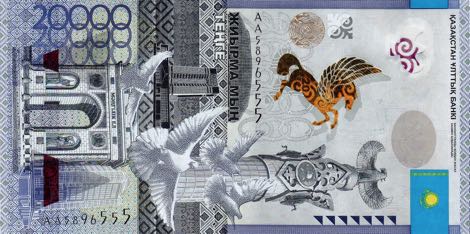
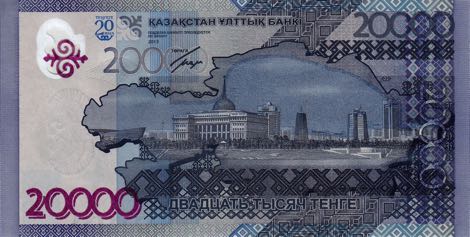
B144 is the first “full circulation” note in the world to be printed on Durasafe, a paper-polymer-paper composite substrate produced by Landqart. It was honored as the Regional Banknote of the Year 2016 at Reconnaissance International’s High Security Printing Europe. Durasafe was previously used on Morocco's commemorative 25-dirham note (B514) issued in December 2012, and will be used on Switzerland's new 20-franc note due for introduction in April 2016.
Kazakhstan new 20,000-tenge note (B144a) confirmed
03 12, 2015 08:47 Category: Central Asia
According to a press release dated 30 November 2015, the National Bank of Kazakhstan introduced a new 20,000-tenge note (B144) on 1 December 2015.
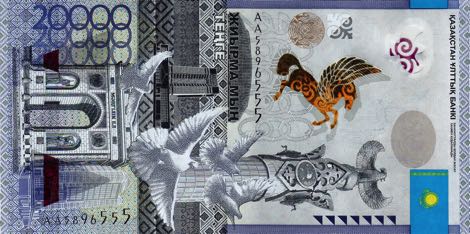

B144 (PNL): 20,000 tenge (US$65)
Blue-gray and violet. Front (vertical): National emblem; SPARK pegasus patch; monumental arch; flying doves and Kazakh Eli monument in Astana; flag. Back: Outline of Kazakhstan; Akorda Palace (the presidential residence in Astana); doves; outline of Kazakhstan. Windowed and solid security threads. Watermark: Mythic Samruk bird with electrotype 20000. Printer: (BFoNBK). 155 x 79 mm.
a. 2013. Sig. 5. Prefix АА, AБ. Intro: 01.12.2015.
This note was printed in 2013 to commemorate the 20th anniversary of the tenge, but was not introduced until 2015.
Replacement notes: Prefix ЛЛ.
Courtesy of Albert Vokhmin, Ömer Yalçinkaya (eBay store ), and Arsentiy Khonin.
), and Arsentiy Khonin.


B144 (PNL): 20,000 tenge (US$65)
Blue-gray and violet. Front (vertical): National emblem; SPARK pegasus patch; monumental arch; flying doves and Kazakh Eli monument in Astana; flag. Back: Outline of Kazakhstan; Akorda Palace (the presidential residence in Astana); doves; outline of Kazakhstan. Windowed and solid security threads. Watermark: Mythic Samruk bird with electrotype 20000. Printer: (BFoNBK). 155 x 79 mm.
a. 2013. Sig. 5. Prefix АА, AБ. Intro: 01.12.2015.
This note was printed in 2013 to commemorate the 20th anniversary of the tenge, but was not introduced until 2015.
Replacement notes: Prefix ЛЛ.
Courtesy of Albert Vokhmin, Ömer Yalçinkaya (eBay store
Kazakhstan new signature 500-tenge note (B129b) confirmed
16 09, 2015 17:08 Category: Central Asia
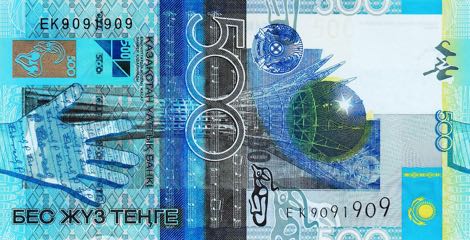

Like B129a, but new signature (Kairat Kelimbetov). Prefix EK, EЛ. Intro: 2015.
Courtesy of Arsentij Khonin.
Kazakhstan new signature 2,000-tenge note (B141b) confirmed
30 06, 2015 09:43 Category: Central Asia
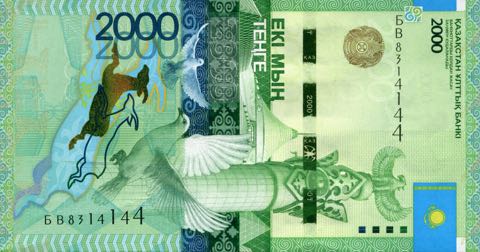

Like B141a, but new signature. Prefix БB.
Courtesy of Thomas Augustsson.
Kazakhstan new 1,000-tenge note (B143a) confirmed
05 01, 2015 08:47 Category: Central Asia
According to a press release dated 12 December 2014, the National Bank of Kazakhstan has introduced a regular issue 1,000-tenge note with new design.
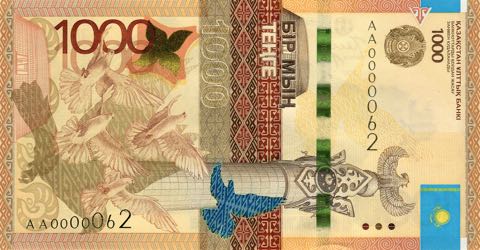
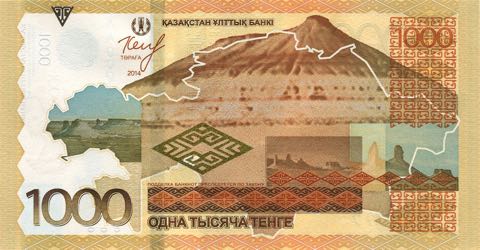
B143 (PNL): 1,000 tenge (US$5.50)
Yellow, brown, orange, and blue. Front (vertical): National emblem; SPARK patch; flying doves and Kazakh Eli monument in Astana; flag. Back: Outline of Kazakhstan; mountains and landscape features of the Ustyurt Plateau. 4-mm wide StarChrome windowed security thread with demetalized 1000, tenge sign, and bird. Watermark: Mythic Samruk bird with electrotype 1000. Printer: (BFoNBK). 134 x 70 mm.
a. 2014. Signature 7. Prefix АА, AБ. Intro: 12.12.2014.
Courtesy of Arsentij Khonin, Cleo Phas, and Ömer Yalçinkaya.


B143 (PNL): 1,000 tenge (US$5.50)
Yellow, brown, orange, and blue. Front (vertical): National emblem; SPARK patch; flying doves and Kazakh Eli monument in Astana; flag. Back: Outline of Kazakhstan; mountains and landscape features of the Ustyurt Plateau. 4-mm wide StarChrome windowed security thread with demetalized 1000, tenge sign, and bird. Watermark: Mythic Samruk bird with electrotype 1000. Printer: (BFoNBK). 134 x 70 mm.
a. 2014. Signature 7. Prefix АА, AБ. Intro: 12.12.2014.
Courtesy of Arsentij Khonin, Cleo Phas, and Ömer Yalçinkaya.
Kazakhstan new signature 1,000-tenge note (B130b) confirmed
13 10, 2014 19:24 Category: Central Asia
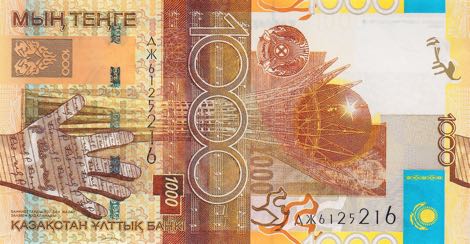

Like B130a, but new signature. Prefix ДЖ.
Courtesy of Ömer Yalçinkaya.
Kazakhstan new signature 5,000-tenge note (B139b) confirmed
11 08, 2014 12:24 Category: Central Asia
Kazakhstan new signature 10,000-tenge note (B140b) confirmed
18 07, 2014 16:39 Category: Central Asia

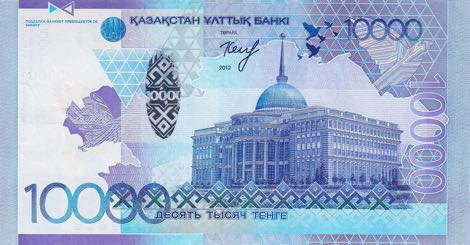
Like B140a, but new signature.
Courtesy of Vadim Tislenko and Ömer Yalçinkaya (stores.ebay.com/Omer-Yalcinkaya-Collection-Shop).
Kazakhstan 1,000-tenge note (B142a) named IBNS Bank Note of the Year 2013
21 05, 2014 06:44 Category: Central Asia

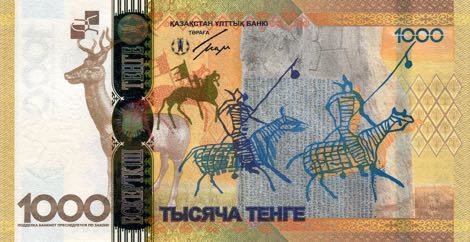
The International Bank Note Society (IBNS) announces that its voting membership has again selected the National Bank of Kazakhstan to receive its prestigious “Bank Note of the Year” Award for 2013. Facing stiff competition as always from the nearly 50 newly designed banknotes released worldwide in 2013, the 1000 Tenge denomination Kazakhstan note was followed in the closest voting ever by the Canada 10 Dollar and Fiji 5 Dollar currency bills.
Now in its 53rd year, the IBNS has over 2000 members worldwide. As a nonprofit educational organization its objectives are to promote, stimulate and advance the study, collection and dissemination of information related to paper money. From all significantly newly designed and widely circulated banknotes released in 2013, the IBNS membership nominated notes from 12 different countries to place on the ballot. Nominees represented four continents and ranged from Europe, Central Asia, Africa, the Middle East, North America, South America and four island nations. Past “Bank Note of the Year” winners include Kazakhstan (2012 & 2011), Uganda (2010), Bermuda (2009), Samoa (2008), Scotland (2007), Comoros (2006), Faeroe Islands (2005) and Canada (2004).
The 2013 winning banknote was produced collaboratively by the Banknote Factory of the National Bank of Kazakhstan and De La Rue Currency of England. The 1000 Tenge bill has a face value of approximately 5.5 U.S. dollars or 4 euros or 3.3 British pounds at early May 2014 exchange rates. The note was issued December 12, 2013. Smaller than U.S. dollar bills, its size of 134 x 70 mm is almost identical to the British 5 pound and European Union 20 euro notes.
The stunning design, predominantly in warm hues of yellow, brown and gold is dedicated to “Kultegin - the Monument of the Turkic Runic Writing,” whose effigy appears on the vertical format face of the note along with the modern “Kazak Eli” monument. The horizontal format reverse side highlights petroglyphic drawings of Turkic warriors against a background monument to Turkic writing. A full color image of this and other nominated banknotes are on the IBNS website.
The IBNS is open to membership from interested persons in any country. Details concerning all IBNS activities are available at www.theibns.org.
Kazakhstan new 20,000-tenge note postponed
19 12, 2013 09:01 Category: Central Asia
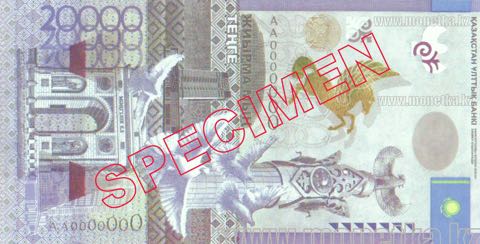
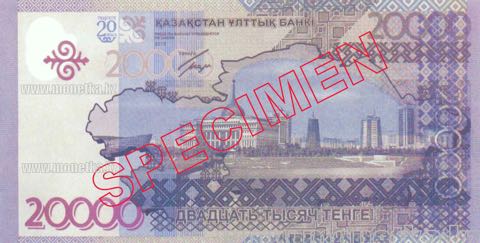
According to an article on Kapital.kz dated 18 December 2013, the National Bank of Kazakhstan has decided not to introduce a 20,000-tenge note at this time due to fears of inflation. At present the largest denomination is the 10,000-tenge note (US$65).
Courtesy of Cleophas Elmakias Schockemohle.
Kazakhstan new 1,000-tenge commemorative note (B142a) confirmed
12 12, 2013 04:57 Category: Central Asia


According to a press release dated 12 December 2013, "In accordance with the Law of the Republic of Kazakhstan No.2155 of 30 March 1995 “On the National Bank of the Republic of Kazakhstan”, the National Bank of the Republic of Kazakhstan, based on the decision of the Management Board of the National Bank of the Republic of Kazakhstan (Resolution No. 263 of 11 November 2013 of the Management Board of the National Bank of the Republic of Kazakhstan “On Determination of the Design and Date of Circulation of the Commemorative Banknote of KZT 1,000 Nominal Value, Dedicated to Kultegin – the Monument of Turkic Runic Writing” signed by Kelimbetov K.N., the Chairman of the National Bank of the Republic of Kazakhstan), announces the issue, effective from 12 December 2013, of the commemorative banknote of KZT 1,000 (one thousand tenge) nominal value, dedicated to “Kultegin” – the monument of the Turkic runic writing.
The commemorative banknote of KZT 1,000 (one thousand tenge) nominal value of the sample of 2013, dedicated to “Kultegin” – the monument of the Turkic runic writing, is made of the paper of size 134 х 70 mm. The prevailing color of the banknote is yellow-brown.
The obverse side of the banknote is a follows: the prevailing images are vertical. The key images are: the monument “Қазақ Елi” (“Kazak Eli”) on the right side of the banknote and images of the flying doves in the bottom right. In the middle of the left part there is a fragment of Kultegin sculpture. In the upper part there are the images of the symbols of state of the Republic of Kazakhstan: the National Emblem and State Flag. The digital notation of the nominal value is printed at the upper left; and below it there is a legend in the state language warning about responsibility for counterfeiting: "Банкноттарды қолдан жасау заңмен қудаланады" (Banknottardy koldan zhasau zanmen kudalanady). To the left there is a horizontally located literal notation of the nominal value in the state language and a legend "ҚАЗАҚСТАН ҰЛТТЫҚ БАНКІ" (KAZAKHSTAN ULTYK BANKI).
The reverse side is as follows: the prevailing images are horizontal. The key images are: petroglyphic drawings of Turkic warriors and the monument of Turkic writing in the background. Lower left and right top there is a digital notation of the banknote nominal value and in the bottom center there is a literal notation of the nominal value in the Russian language. On the left side there is a holographic band of 12 mm wide with the image of a fragment of the State Flag, the National Bank’s logo and a legend “Ескерткіш теңге” (Eskertkish tenge). A legend “ҚАЗАҚСТАН ҰЛТТЫҚ БАНКІ" (KAZAKHSTAN ULTYK BANKI) is printed in the top middle. In the lower left corner, under the digital notation of the banknote nominal value, there is a legend “Подделка банкнот преследуется по закону” (“Counterfeiting is prosecuted under the law”).
The circulation of the commemorative banknote of KZT 1,000 (one thousand tenge) dedicated to Kultegin – the monument of Turkic runic writing - is 10,000,000."
Courtesy of Vadim Tislenko and Arsentij Khonin.
Kazakhstan 5,000-tenge note (B139a) named IBNS Bank Note of the Year 2012
15 05, 2013 07:49 Category: Central Asia
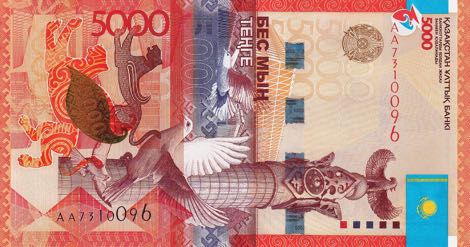

The International Bank Note Society (IBNS) announces that its voting membership has again selected the National Bank of Kazakhstan to receive its prestigious “Bank Note of the Year” Award for 2012. Facing stiff competition as always from nearly 100 new banknotes released worldwide in 2012, the 5000 Tenge denomination Kazakhstan note was followed in voting by the Canada 50 Dollar and Jersey 100 Pound currency bills.
Now in its 52nd year, the IBNS has over 2000 members worldwide. As a nonprofit educational organization its objectives are to promote, stimulate and advance the study, collection and dissemination of information related to paper money. From all significantly newly designed and widely circulated banknotes released in 2012, the IBNS membership nominated notes from 13 different countries to place on the ballot. Nominees represented four continents and ranged from Europe, Asia, Africa and the Middle East to North, South and Central America. Past “Bank Note of the Year” winners include Kazakhstan (2011), Uganda (2010), Bermuda (2009), Samoa (2008), Scotland (2007), Comoros (2006), Faeroe Islands (2005) and Canada (2004).
The 2012 winning banknote was designed collaboratively by De La Rue of England and the National Bank. The Banknote Factory of the National Bank of Kazakhstan undertook the printing. The 5000 Tenge bill has a face value of approximately 33 U.S. dollars or 25 euros or 22 British pounds at early-May 2013 exchange rates. The note was issued 30 December 2011 for circulation in 2012. Slightly narrower, but taller, than U.S. dollar bills, its size is almost identical to the 20 pound English and 50 Euro notes.
The stunning design, predominantly in vivid reddish-orange features the “Kazak Eli” monument with flying doves and panther in a vertical format on the face of the banknote. The horizontal format reverse side highlights a map of the country with mountains and the “Monument of Independence” with the Kazakhstan Hotel in the former capital city of Almaty. A full color image of this and other nominated banknotes are on the IBNS website.
The IBNS is open to membership from interested persons in any country. Details concerning all IBNS activities are available at www.theibns.org.
Kazakhstan new 2,000-tenge note (B141a) confirmed
08 04, 2013 01:09 Category: Central Asia
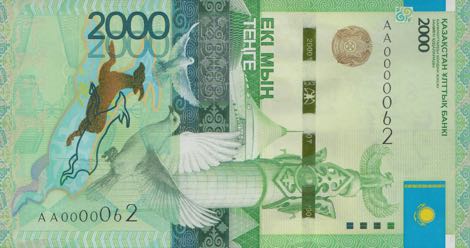

According to a press release from the Naitonal Bank of the Rupublic of Kazkhstan, a new 2,000-tenge note was issued 29 March 2013. "The banknote of KZT 2,000 (two thousand) nominal value with a modified design is made of the paper of 139х73 mm. The obverse side of the banknote is a follows: the prevailing colors are dark green and light green; the prevailing images are vertical. The key images: the monument “Қазақ Елi” (“Kazak Eli”) on the right side of the banknote and images of the flying doves in the bottom center. At the bottom of the banknote there is a figure of saiga antelope made with the color- shifting paint. In the upper part there are the images of the symbols of state of the Republic of Kazakhstan: national emblem and state flag. The digital notation of the nominal value is printed on the left side, above and below; on the left center there is a digital notation of the nominal value in the state language. The legend "ҚАЗАҚСТАН ҰЛТТЫҚ БАНКІ" (KAZAKHSTAN ULTYK BANKI) is in the upper left corner; below there is a legend in the state language warning about responsibility for counterfeiting: "Банкноттарды қолдан жасау заңмен қудаланады" (Banknottardy koldan zhasau zanmen kudalanady)."
"The reverse side is as follows: the prevailing colors are dark green and light green; the prevailing images are horizontal. The key image is an outline of Kazakhstan map contour with the image of Irtysh River. On the right side there is a holographic band of 13 mm wide with the image of nominal value, a stylized yurt and fragment of the state flag. Lower left, right top and lower right there is a digital notation of the banknote nominal value and in the bottom center there is a literal notation of the nominal value in the Russian language. A legend “ҚАЗАҚСТАН ҰЛТТЫҚ БАНКІ", is printed in the top middle; in the lower left corner, under the notation of the banknote nominal value, there is a legend “Подделка банкнот преследуется по закону” (“Counterfeiting is prosecuted under the law”)."
Courtesy of Ömer Yalçinkaya and Arsentiy Khonin.
Kazakhstan accepts IBNS Bank Note of the Year award
09 12, 2012 07:10 Category: Central Asia
This CapioNet page contains an article and English-language video showing the chairman of the National Bank of Kazakhstan accepting the IBNS Bank Note of the Year award for 2011.
Kazakhstan new date (2012) non-commemorative 10,000-tenge note (B140a) confirmed
23 06, 2012 14:11 Category: Central Asia

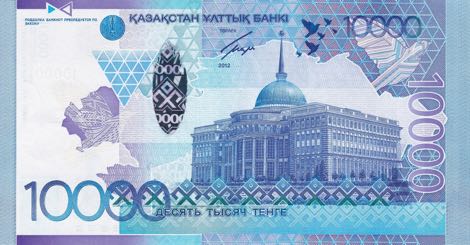
On 28 May 2012, the National Bank of Kazakhstan introduced a 10,000-tengé (US$69) note like B138, but without the 20th anniversary logo on back, and a new date of 2012. The commemorative issue of this note recently received the IBNS Bank Note of the Year award.
Courtesy of Andrew Randall, Thomas Krause, and Ömer Yalcinkaya (stores.ebay.com/Omer-Yalcinkaya-Collection-Shop).
Kazakhstan 10,000-tenge note (B138a) named IBNS Bank Note of the Year 2011
20 05, 2012 09:52 Category: Central Asia

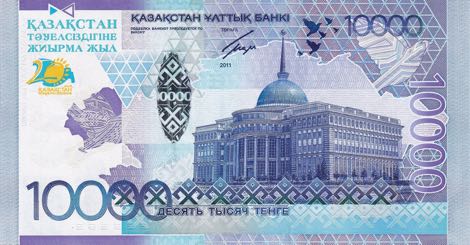
The International Bank Note Society (IBNS) announces that its voting membership has selected the National Bank of Kazakhstan to receive its prestigious “Bank Note of the Year” Award for 2011. Facing stiff competition as always from almost 100 new banknotes released worldwide in 2011, the 10,000 Tenge denomination Kazakhstani note [NBK B38 (PNL)] was followed in voting by the Canada 100 Dollar and Gibraltar 100 Pound currency bills [GOG B34 (P39)].
Now in its 51st year, the IBNS has over 2000 members worldwide. As a non-profit educational organization its objectives are to promote, stimulate and advance the study, collection and dissemination of information related to paper money. From all significantly newly designed and widely circulated banknotes released in 2011, the IBNS board of directors nominated notes from 12 different countries to place on the ballot. Nominees represented 5 continents and ranged from the fledgling country of South Sudan to the venerable Bank of England. Past “Bank Note of the Year” winners include Uganda (2010), Bermuda (2009), Samoa (2008), Scotland (2007), Comoros (2006), Faeroe Islands (2005) and Canada (2004).
The 2011 winning banknote was designed collaboratively by De La Rue of England and the National Bank. The Banknote Factory of the National Bank of Kazakhstan undertook the printing. The 10,000 Tenge bill has a face value of approximately 68 U.S. dollars or 53 euro or 42 British pounds at mid-May 2012 exchange rates. The note was released 4 July 2011 with a circulation of 30 million pieces to commemorate 20 years of Independence for the Republic of Kazakhstan. Slightly larger than either the 50 euro or U.S. dollar bills, its size is almost identical to the English 20 pound note.
The stunning design, predominantly in dark blue-violet features the “Kazak Eli” monument with flying birds in a vertical format on the face of the banknote. The horizontal format reverse side highlights the Presidential Palace in the new capital city of Astana and a map of the country. A full color image of this and other Kazakh banknotes can be viewed on the National Bank’s website.
The IBNS is open to membership from interested persons in any country. Details concerning all IBNS activities are available at www.theibns.org.
Kazakhstan new 5,000-tenge note (B139a) confirmed
12 02, 2012 10:08 Category: Central Asia


On 7 January 2012, the ҚАЗАҚСТАН ҰЛТТЫҚ БАНКІ (National Bank of Kazakhstan) issued a press release in Kazakh regarding a new 5,000-tengé (US$34) note dated 2011.
B139 (PNL): 5,000 tengé
Red, blue, yellow, and green. Front (vertical): OVI national emblem; stylized snow leopards; birds; Kazakh Eli monument in Astana; flag. Back: Outline of Kazakhstan; Zailijsky Alatau ridge of Tjan-Shan mountain range; field of flowers; Independence Monument and Kazakhstan hotel in Almaty. Solid security thread. Holographic stripe with apples, birds, and 5000. 6-mm wide windowed security thread. Watermark: Mythic Samruk bird with electrotype 5000. Printer: (BFoNBK). 144 x 76 mm.
a. 2011. Signature 5. Intro: 30.12.2011.
as. Diagonal red УЛГІ ovpt; horizontal red # ovpt at lower center.
Courtesy of Ömer Yalcinkaya.
Kazakhstan chapter of The Banknote Book is now available
20 05, 2011 19:29 Category: The Banknote Book | Central Asia
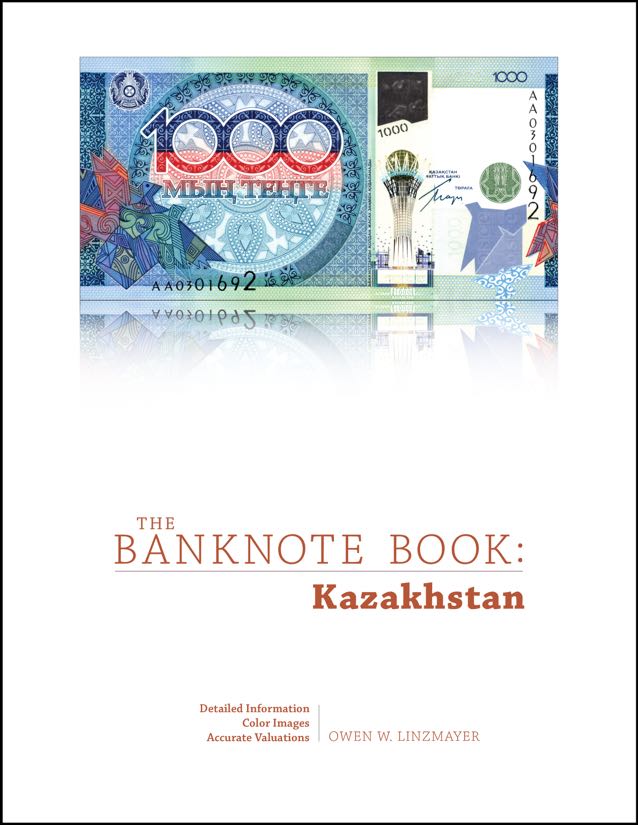
The Kazakhstan chapter of The Banknote Book is now available for individual sale and as a free download to subscribers.
This 20-page catalog covers notes issued by the National Bank of Kazakhstan from 1993 to present. Revised 25.10.2018.
Each chapter of The Banknote Book includes detailed descriptions and background information, full-color images, and accurate valuations. The Banknote Book also features:
- Sharp color images of note’s front and back without overlap
- Face value or date of demonetization if no longer legal tender
- Specific identification of all vignette elements
- Security features described in full
- Printer imprint reproduced exactly as on note
- Each date/signature variety assigned an individual letter
- Variety checkboxes for tracking your collection and want list
- Date reproduced exactly as on note
- Precise date of introduction noted when known
- Replacement note information
- Signature tables, often with names and terms of service
- Background information for historical and cultural context
- Details magnified to distinguish between note varieties
- Bibliographic sources listed for further research
Subscribe to The Banknote Book
If you collect the entire world or a large number of countries, buying a subscription is the best deal because it's less expensive than buying chapters individually, and it entitles you to every chapter currently available as well as everything published—or revised (click here to see the Change Log)—during the term of your subscription.

Sign up for Email Notifications
If you would like to receive email notifications whenever a new chapter of The Banknote Book is published, please join the email list.

Kazakhstan new 1,000-tenge commemorative and specimen confirmed
26 06, 2011 15:33 Category: Central Asia | Commemorative

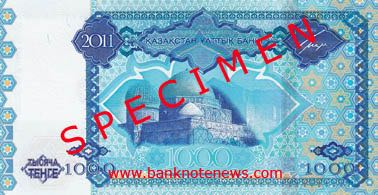
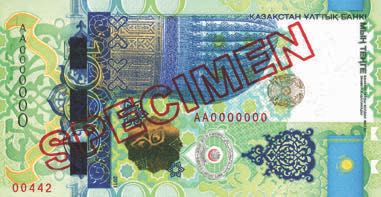
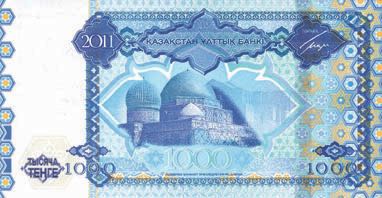
1,000 tengé (US$6.90), 2011. Ten million banknotes were introduced on 25 May 2011 to commemoratie the Republic of Kazakhstan's chairmanship in the Organisation of the Islamic Conference.
Obverse: The images are vertical. The main image in the middle of the banknote: the dome of the mausoleum of Hodja Akhmed Yassavi. On the left is the official logo of the Organisation of the Islamic Conference. The face value is placed in the lower part of the banknote. The upper part shows the state symbols of the Republic of Kazakhstan: National Emblem and National Flag. The name of the issuing bank, in Kazakh, is placed vertically in the top left, above the name there is an inscription in the Kazakh language stating that counterfeiting banknotes is against the law.
Reverse: The images are horizontal. The main image is the mausoleum of Hodja Akhmed Yassavi. . The face value is placed in the bottom left, in the middle and the right part. The name of the issuing bank, in the Kazakh language is in the middle of the upper half of the note. At the bottom in the middle of the banknotes, there is an inscription in Russian stating that counterfeiting banknotes is against the law.
Courtesy of Vadim Tislenko and Ömer Yalcinkaya.
Kazakhstan new 10,000-tenge commemorative note (B138a) confirmed
08 07, 2011 08:55 Category: Central Asia | Commemorative
In the second quarter of 2010, the board of the National Bank of the Republic of Kazakhstan adopted at its meetings 34 resolutions, including one “On emission of an anniversary banknote of KZT 10,000 (ten thousand) denomination devoted to the 20th anniversary of independence of the Republic of Kazakhstan.”


B138 (PNL): 10,000 tengé (US$69)
Violet and blue. Front (vertical): National emblem; birds; Kazakh Eli monument in Astana; flag. Back: 20th anniversary logo; outline of Kazakhstan; Akorda Palace (the presidential residence in Astana); birds. Copper stripe. Solid security thread. Optiks security thread. Solid security thread. Watermark: Eagle with spread wings. Printer: (TDLR and BFoNBK). 149 x 79 mm. 2011. Signature 5. Intro: 04.07.2011.
Courtesy of Ted Sofos, Vadim Tislenko, and Ömer Yalcinkaya.


B138 (PNL): 10,000 tengé (US$69)
Violet and blue. Front (vertical): National emblem; birds; Kazakh Eli monument in Astana; flag. Back: 20th anniversary logo; outline of Kazakhstan; Akorda Palace (the presidential residence in Astana); birds. Copper stripe. Solid security thread. Optiks security thread. Solid security thread. Watermark: Eagle with spread wings. Printer: (TDLR and BFoNBK). 149 x 79 mm. 2011. Signature 5. Intro: 04.07.2011.
Courtesy of Ted Sofos, Vadim Tislenko, and Ömer Yalcinkaya.
Kazakhstan new 2,000-tenge commemorative (B136a) confirmed
02 02, 2011 10:05 Category: Central Asia | Commemorative
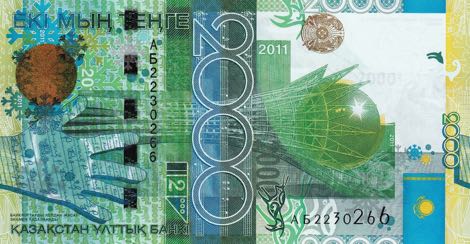
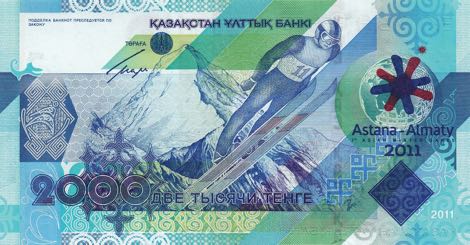
On 17 January 2011, the National Bank of Kazakhstan issued a new 2,000-tenge (US$13.60) banknote to mark the 2011 Asian Winter Games hosted by Kazakhstan. The banknote bears the emblem of the 7th Asian Winter Games that are scheduled to be held in Astana and Almaty from 30 January to 6 February.
2,000-tenge (US$13.60)
Green and blue. Front (vertical): Snowflakes; Astana-Baiterek monument; sheet music; national emblem; palm; flag. Back: Mountain; ski jumper; globe emblem of the 7th Asian Winter Games. Solid security thread. Windowed security thread with demetalized 2000 and text along scrolling line. Watermark: Snow leopard with electrotype 2000. Printer: (TDLR and BFoNBK). 139 x 73 mm. 2011. Signature 5. Intro: 17.01.2011.
Courtesy of Omer Yalcinkaya, Thomas Krause, Claudio Marana, Vadim Tislenko, and Nazir Rahemtulla.
Book review: Apples Are From Kazakhstan
05 10, 2010 07:59 Category: Book | Central Asia
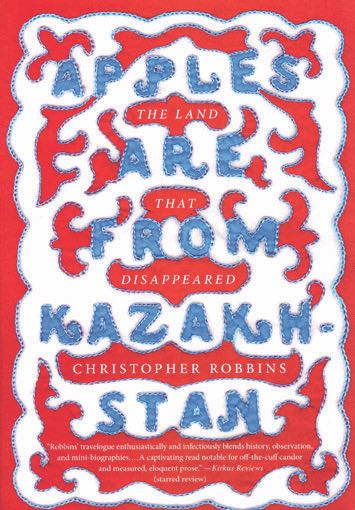
Apples Are From Kazakhstan:: The Land that Disappeared by Christopher Robbins (Order from Amazon.com)
This 296-page paperback book is a fascinating look at a country most Westerners barely know. The English author Robbins does a wonderful job of weaving his personal experiences in this former Soviet republic with rich historical background, from ancient times to repression under Russian rule in the last century. Of particular interest to banknote collectors is the chapter in which Robbins recounts the secret—and ultimately successful—plan to introduce tenge banknotes in 1993 to avoid being at the mercy of Moscow when it replaced the Soviet ruble with the new Russian ruble.
Check out other book reviews and news on the Books page of this site.
New holographic technology has designs on banknote security
06 07, 2010 09:03 Category: Miscellaneous
Technology continues to push the boundaries for banknote security holograms. Here, Dr Glenn Wood of the International Hologram Manufacturers Association looks at some of the latest developments.
Today, holographic technology remains very much to the fore as part of an array of overt features which make it quick and easy for people to recognise whether or not a banknote is bonafide. But new substrate technology, particularly the introduction of transparent ‘windows’ is being incorporated on banknotes to provide new levels of anti-counterfeiting complexity.
The commemorative 1,000 Tenge note produced by Papierfabrik Louisenthal for Kazakhstan and launched earlier this year takes optical sophistication to a new level. Not only does it feature a hologram showing typical rainbow colours but a small microlenticular patch viewed by transmission. The system is called Varifeye® and combines the best features of paper and polymer.

The optically variable feature on the new 1000 Tenge note of Kazakhstan showing microlenticular feature in the window and demetallised hologram below.
Previously, a deckle-edge window was created in the paper substrate during the process of cylinder-mould web formation as the stock fibers collect against the deckle, leading to the characteristic feather look. Latterly, the window has been cut into the paper after laminating to a polymeric layer. Then a clear stripe of film is laminated over it running from top to bottom of the note. The clear stripe contains the microlenticular image of a camel interchanging with the letter ‘K’ when tilted.
This feature can be viewed by transmission through the window. There is also a demetallised holographic image of the Astana Baiterek monument above the text ‘Organisation for Security & Co-operation in Europe’, interchanging with the date 2010 which are viewed by reflection where it falls over the paper. (This technology was first used on the Bulgarian lev banknotes in 2005, becoming the world’s first paper notes with see through window).
For polymeric substrates, the Bank of Australia has developed its Non-diffractive Switching Image (NSI). This appears like a dynamic watermark in the clear window of a polymer-based note. Being non-diffractive, the images are seen in varying shades of grey rather than rainbow colours and switching of the image elements occurs by rotation rather than tilting.
Mexico has also embraced new technology – the country’s 100 peso note has an ingenious feature which outwardly looks holographic but is in fact transparent optically variable inks (they are usually opaque) printed on the clear window of a polymer note. The viewer can look at the feature either by transmission or reflection. The inks change colour in both modes but the colours seen by transmission are the complementary colours of those seen by reflection.
The latest innovation in holographic technology which makes use of traditional (though modified) embossing technology is the Asterium feature from Toppan printing in Japan. Viewed in normal direct light this feature appears black but when inclined at an extreme angle, the rainbow colours of an embossed hologram appear. The important feature here is the optical black which gives a new aesthetic to documents and only reveals the colourful security feature as and when required.

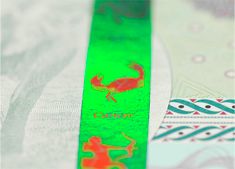
Asterium from Toppan uses optical black in conjunction with a hologram.
Another innovator, Kurz, has developed a revolutionary wafer thin security photopolymer which can record a volume holographic image for banknotes produced for Swiss National Bank. Kurz’s success has been to develop the material thin enough for use on a banknote, especially given that the reason this is called a ‘volume’ hologram is that the interference fringes are recorded within the depth of the photo-sensitive material. Similar developments are taking place in Japan where Dai Nippon Printing is leading the way.
OVD Kinegram, a division of Leonhard Kurz, continues to push the boundaries with its Kinegram reColor®. This has been developed for use as a laminate in conjunction with a window or aperture in the banknote substrate, and provides fundamentally different, and unexpected, effects depending on whether the note is viewed from the front or reverse. On the front the viewer sees a normal metallised reflective, diffractive image, while the reverse view shows a patterned coloured foil also displaying the diffractive features. The trick is performed using different coloured resist lacquers in the demetallization process. More remarkable still is Kinegram reView® which appears the same, metallic color on both sides of the image although the images seen on the two faces can be different and unrelated to each other.
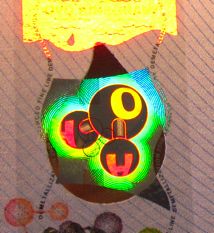
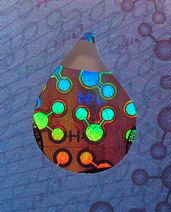
ReView from L. Kurz displays different holographic images when viewed from opposite side of a window.
One way or another, it seems that the window technology now becoming available to printers of banknotes is here to stay. Formerly, the opaque nature of security printing paper only allowed a watermark to be seen by transmission but most holograms are, by nature, transmissive and are rendered reflective by applying a metal coating. Once the opportunity is presented to allow them to be seen by transmission, as in a window, the opportunities for an optical tour de force are increased. This renders the note more visually attractive to inspectors and consumers and more difficult to simulate by counterfeiters.
However, here’s a cautionary word. Any trend towards simplification must be seen as a move in the right direction and run hand in hand with artists and graphic designers’ abilities to make good use of the media or of the public’s ability to appreciate and evaluate the security benefits offered by the latest technology. After all, it’s not as though holograms represent the only security feature on a banknote.
They are often one of many - for example, the 1000 Tenge note for Kazakhstan has at least 16 features including one to help the blind or partially sighted. So, it isn’t necessary to fill the hologram with every conceivable feature rather remember why the hologram was originally introduced: it provided a feature that could not be photocopied. Photopolymers provide this, so there’s no reason to suppose that holographic technology will not continue to be an integral security feature on future generations of banknotes.
END
The International Hologram Manufacturers Association (IHMA) is made up of 90 of the world's leading hologram companies. IHMA members are the leading producers and converters of holograms for banknote security, anti-counterfeiting, brand protection, packaging, graphics and other commercial applications around the world. IHMA member companies actively cooperate to maintain the highest professional, security and quality standards.
Issued on behalf of the IHMA by Mitchell Halton Watson Ltd. For further details contact Andy Bruce on +44 (0) 191 233 1300 or email andy@mhwpr.co.uk
Today, holographic technology remains very much to the fore as part of an array of overt features which make it quick and easy for people to recognise whether or not a banknote is bonafide. But new substrate technology, particularly the introduction of transparent ‘windows’ is being incorporated on banknotes to provide new levels of anti-counterfeiting complexity.
The commemorative 1,000 Tenge note produced by Papierfabrik Louisenthal for Kazakhstan and launched earlier this year takes optical sophistication to a new level. Not only does it feature a hologram showing typical rainbow colours but a small microlenticular patch viewed by transmission. The system is called Varifeye® and combines the best features of paper and polymer.

The optically variable feature on the new 1000 Tenge note of Kazakhstan showing microlenticular feature in the window and demetallised hologram below.
Previously, a deckle-edge window was created in the paper substrate during the process of cylinder-mould web formation as the stock fibers collect against the deckle, leading to the characteristic feather look. Latterly, the window has been cut into the paper after laminating to a polymeric layer. Then a clear stripe of film is laminated over it running from top to bottom of the note. The clear stripe contains the microlenticular image of a camel interchanging with the letter ‘K’ when tilted.
This feature can be viewed by transmission through the window. There is also a demetallised holographic image of the Astana Baiterek monument above the text ‘Organisation for Security & Co-operation in Europe’, interchanging with the date 2010 which are viewed by reflection where it falls over the paper. (This technology was first used on the Bulgarian lev banknotes in 2005, becoming the world’s first paper notes with see through window).
For polymeric substrates, the Bank of Australia has developed its Non-diffractive Switching Image (NSI). This appears like a dynamic watermark in the clear window of a polymer-based note. Being non-diffractive, the images are seen in varying shades of grey rather than rainbow colours and switching of the image elements occurs by rotation rather than tilting.
Mexico has also embraced new technology – the country’s 100 peso note has an ingenious feature which outwardly looks holographic but is in fact transparent optically variable inks (they are usually opaque) printed on the clear window of a polymer note. The viewer can look at the feature either by transmission or reflection. The inks change colour in both modes but the colours seen by transmission are the complementary colours of those seen by reflection.
The latest innovation in holographic technology which makes use of traditional (though modified) embossing technology is the Asterium feature from Toppan printing in Japan. Viewed in normal direct light this feature appears black but when inclined at an extreme angle, the rainbow colours of an embossed hologram appear. The important feature here is the optical black which gives a new aesthetic to documents and only reveals the colourful security feature as and when required.


Asterium from Toppan uses optical black in conjunction with a hologram.
Another innovator, Kurz, has developed a revolutionary wafer thin security photopolymer which can record a volume holographic image for banknotes produced for Swiss National Bank. Kurz’s success has been to develop the material thin enough for use on a banknote, especially given that the reason this is called a ‘volume’ hologram is that the interference fringes are recorded within the depth of the photo-sensitive material. Similar developments are taking place in Japan where Dai Nippon Printing is leading the way.
OVD Kinegram, a division of Leonhard Kurz, continues to push the boundaries with its Kinegram reColor®. This has been developed for use as a laminate in conjunction with a window or aperture in the banknote substrate, and provides fundamentally different, and unexpected, effects depending on whether the note is viewed from the front or reverse. On the front the viewer sees a normal metallised reflective, diffractive image, while the reverse view shows a patterned coloured foil also displaying the diffractive features. The trick is performed using different coloured resist lacquers in the demetallization process. More remarkable still is Kinegram reView® which appears the same, metallic color on both sides of the image although the images seen on the two faces can be different and unrelated to each other.


ReView from L. Kurz displays different holographic images when viewed from opposite side of a window.
One way or another, it seems that the window technology now becoming available to printers of banknotes is here to stay. Formerly, the opaque nature of security printing paper only allowed a watermark to be seen by transmission but most holograms are, by nature, transmissive and are rendered reflective by applying a metal coating. Once the opportunity is presented to allow them to be seen by transmission, as in a window, the opportunities for an optical tour de force are increased. This renders the note more visually attractive to inspectors and consumers and more difficult to simulate by counterfeiters.
However, here’s a cautionary word. Any trend towards simplification must be seen as a move in the right direction and run hand in hand with artists and graphic designers’ abilities to make good use of the media or of the public’s ability to appreciate and evaluate the security benefits offered by the latest technology. After all, it’s not as though holograms represent the only security feature on a banknote.
They are often one of many - for example, the 1000 Tenge note for Kazakhstan has at least 16 features including one to help the blind or partially sighted. So, it isn’t necessary to fill the hologram with every conceivable feature rather remember why the hologram was originally introduced: it provided a feature that could not be photocopied. Photopolymers provide this, so there’s no reason to suppose that holographic technology will not continue to be an integral security feature on future generations of banknotes.
END
The International Hologram Manufacturers Association (IHMA) is made up of 90 of the world's leading hologram companies. IHMA members are the leading producers and converters of holograms for banknote security, anti-counterfeiting, brand protection, packaging, graphics and other commercial applications around the world. IHMA member companies actively cooperate to maintain the highest professional, security and quality standards.
Issued on behalf of the IHMA by Mitchell Halton Watson Ltd. For further details contact Andy Bruce on +44 (0) 191 233 1300 or email andy@mhwpr.co.uk
Kazakhstan new 1,000-tenge commemorative note (B135a) confirmed
28 01, 2010 10:02 Category: Central Asia | Commemorative

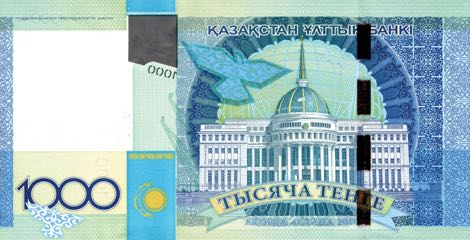
The National Bank of Kazakhstan issued a new 1,000-tenge note on 5 January 2010 to commemorate Kazakhstan’s chairmanship of the Organization for Security and Co-operation in Europe in 2010.
A total of 10 million notes will be issued at face value (US$6.75). The note dated 2010 is the same size (134 x 70 mm) as the current note of the same denomination, though the color is now turquoise-green, and the designs are as follows:
Obverse: State Emblem of the Republic of Kazakhstan in left upper corner, decorative image of flying birds in national style, face value in Kazakh language in the center, motives of Kazakh national patterns along the banknote, holographic image of Baiterek monument , color-changing logo of National Bank of Kazakhstan on the right part
Reverse: State Flag of the Republic in the left lower corner, Akorda palace of President of the Republic of Kazakhstan in the center with face value in Russian language, image of a bird and year of issue 2010, numerical indication of face value in the left lower part, motives of Kazakh national patterns along the banknote.
Courtesy of Vadim Tislenko.
Kazakhstan new 5,000-tenge commemorative note (B134a) confirmed
19 09, 2008 08:29 Category: Central Asia | Commemorative

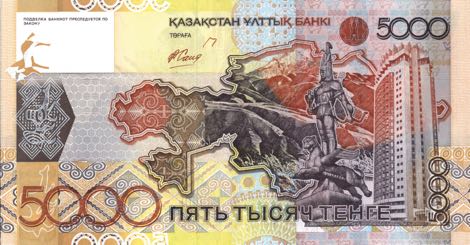
5,000 tenge (US$41.30), 2008. Introduced 2008 to commemorate 15 years of tenge. Red and brown on m/c underprint. Front: Astana-Baiterek monument; sheet music; national emblem; palm; flag; green-to-blue Spark flying eagle; jubilee inscription at edges. Back: Independence Monument and Kazakhstan hotel in Almaty; mountains. Watermark, windowed security thread, registration device, intaglio printing, OVI, microprinting, fluorescent serial numbers, iridescent ink, latent image of denomination, and pink fibers that fluoresce red under UV light. Printer: De La Rue (w/o imprint). 144 x 76 mm.
Also available as a specimen with all-zero serial numbers, red diagonal SPECIMEN overprint, numbered in the lower right-hand front corner.
Kazakhstan’s new note series misspells “bank”
18 10, 2006 10:41 Category: Central Asia
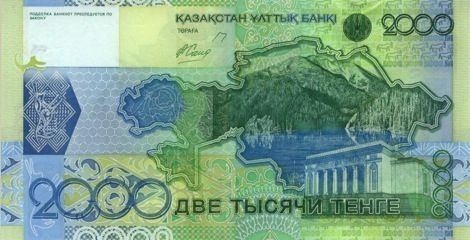


Officials at the National Bank of Kazakhstan admit that there’s a problem with the new series of notes issued on November 15. The word “bank” on some of the new notes is misspelled with an alternate Kazakh form of the letter K (above, top), not the Cyrillic version (above, bottom), which has a slightly different pronunciation. Despite politicians’ calls to scrap the new issue, bank officials plan to release the error notes and then gradually withdraw them from circulation.
This error affects only some 2,000- and 5,000-tenge notes, and not the other denominations in this new series. Curiously, the misspelled “bank” appears on both sides of the KZT2,000 (US$15.65), but only on the face of the KZT5,000 (US$39.10).
Courtesy of Olexandr Danishenko and Eduard Han.
Kazakhstan issues new note series
15 11, 2006 10:14 Category: Central Asia
Today the National Bank of Kazakhstan began issuing a new series of notes. This completely redesigned series share similar design elements on front (vertical format) and back (horizontal), distinguished primarily by different color schemes and printed denominations. The previous series (Pick 20 - 27) featuring a portrait of Al-Farabi will circulate in parallel with the new series for a period of one year.
The front of each note features the Astan-Baiterek monument in center, with a fragment of printed music of the national anthem overprinted with the numerical denomination. National emblem at left, along with an opened palm, and flag at right. The back of each note features a different main image within the outline of Kazakhstan’s boundaries.
The following security features appear on all notes: watermark, metallic windowed security thread, registration device, intaglio printing, OVI, microprinting, fluorescent serial numbers, iridescent ink, latent image of denomination, and pink fibers that fluoresce red under UV light.

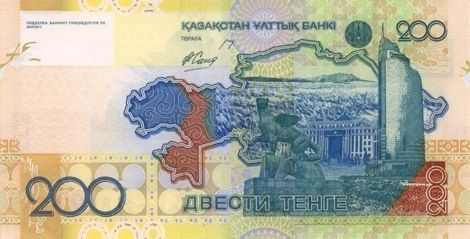
200 tenge, 2006. Orange and green. Front (vertical): Astana-Baiterek monument; sheet music; national emblem; palm; flag. Back: Transport and Communication Ministry building; winged statue on bridge over river Ishim in Astana; Ministry of Defense building; steppe. Solid security thread. Windowed security thread with demetalized 200 and text. Watermark: Snow leopard with electrotype 200 and deer. Printer: (BFoNBK). 126 x 64 mm.
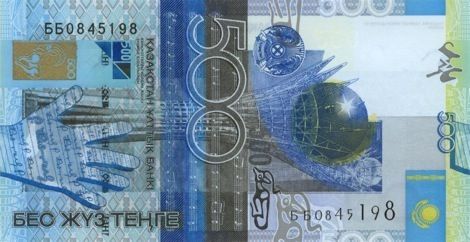
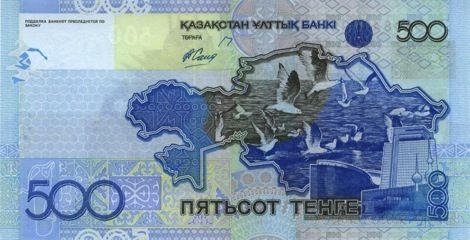
500 tenge, 2006. Blue and gray. Front (vertical): Astana-Baiterek monument; sheet music; national emblem; palm; flag. Back: Ministry of Finance building; Astana city hall; gulls over the sea. Solid security thread. Windowed security thread with demetalized 500 and text. Watermark: Snow leopard with electrotype 500 and animal lying down. Printer: (BFoNBK). 130 x 67 mm.
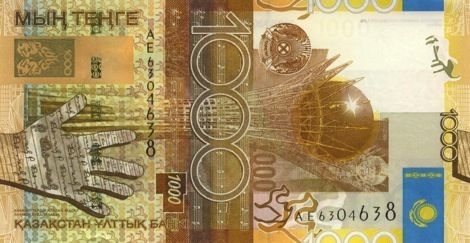

1,000 tenge, 2006. Yellow and brown on m/c underprint. Front (vertical): Astana-Baiterek monument; sheet music; national emblem; palm; flag. Back: Presidential Culture Center building; mesas. Solid security thread. Windowed security thread with demetalized 1000 ТЕҢГЕ and ornament. Watermark: Snow leopard with electrotype 1000 and camel. Printer: (BFoNBK). 134 x 70 mm.

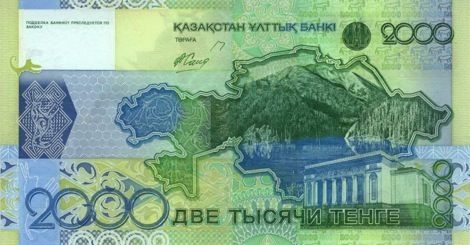
2,000 tenge, 2006. Green and blue. Front (vertical): Astana-Baiterek monument; sheet music; national emblem; palm; flag. Back: Abai Opera-House building in Almaty; mountain lake. Solid security thread. Windowed security thread with demetalized 2000 and text along scrolling line. Watermark: Snow leopard with electrotype 2000. Printer: (TDLR and BFoNBK). 139 x 73 mm.
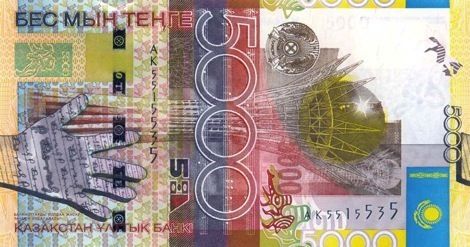
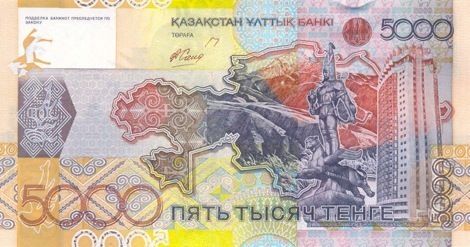
5,000 tenge, 2006. Red and brown. Front (vertical): Astana-Baiterek monument; sheet music; national emblem; palm; flag. Back: Independence Monument and Kazakhstan hotel in Almaty; mountains. Solid security thread. Windowed security thread with demetalized 5000 ТЕҢГЕ and ornament. Watermark: Snow leopard with electrotype 5000. Printer: (TDLR and BFoNBK). 144 x 76 mm.
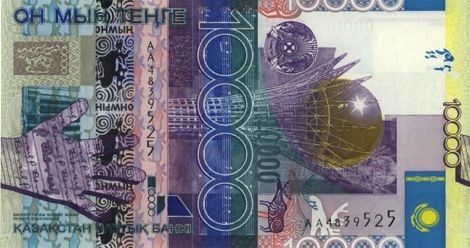
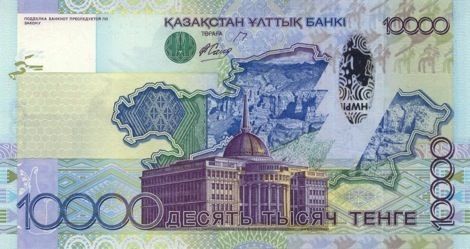
10,000 tenge, 2006. Violet and blue. Front (vertical): Astana-Baiterek monument; sheet music; national emblem; palm; flag. Back: Akorda Palace (the presidential residence in Astana); canyons. Optiks security thread. Solid security thread. Watermark: Snow leopard with electrotype 10000 and elk. Printer: (TDLR and BFoNBK). 149 x 79 mm.
All notes have the same watermark of a leopard head, along with electrotype denomination and different animals (such as the camel shown here).
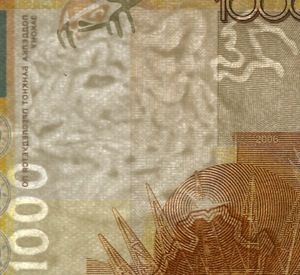
Courtesy of Olexandr Danishenko and Eduard Han.
The front of each note features the Astan-Baiterek monument in center, with a fragment of printed music of the national anthem overprinted with the numerical denomination. National emblem at left, along with an opened palm, and flag at right. The back of each note features a different main image within the outline of Kazakhstan’s boundaries.
The following security features appear on all notes: watermark, metallic windowed security thread, registration device, intaglio printing, OVI, microprinting, fluorescent serial numbers, iridescent ink, latent image of denomination, and pink fibers that fluoresce red under UV light.


200 tenge, 2006. Orange and green. Front (vertical): Astana-Baiterek monument; sheet music; national emblem; palm; flag. Back: Transport and Communication Ministry building; winged statue on bridge over river Ishim in Astana; Ministry of Defense building; steppe. Solid security thread. Windowed security thread with demetalized 200 and text. Watermark: Snow leopard with electrotype 200 and deer. Printer: (BFoNBK). 126 x 64 mm.


500 tenge, 2006. Blue and gray. Front (vertical): Astana-Baiterek monument; sheet music; national emblem; palm; flag. Back: Ministry of Finance building; Astana city hall; gulls over the sea. Solid security thread. Windowed security thread with demetalized 500 and text. Watermark: Snow leopard with electrotype 500 and animal lying down. Printer: (BFoNBK). 130 x 67 mm.


1,000 tenge, 2006. Yellow and brown on m/c underprint. Front (vertical): Astana-Baiterek monument; sheet music; national emblem; palm; flag. Back: Presidential Culture Center building; mesas. Solid security thread. Windowed security thread with demetalized 1000 ТЕҢГЕ and ornament. Watermark: Snow leopard with electrotype 1000 and camel. Printer: (BFoNBK). 134 x 70 mm.


2,000 tenge, 2006. Green and blue. Front (vertical): Astana-Baiterek monument; sheet music; national emblem; palm; flag. Back: Abai Opera-House building in Almaty; mountain lake. Solid security thread. Windowed security thread with demetalized 2000 and text along scrolling line. Watermark: Snow leopard with electrotype 2000. Printer: (TDLR and BFoNBK). 139 x 73 mm.


5,000 tenge, 2006. Red and brown. Front (vertical): Astana-Baiterek monument; sheet music; national emblem; palm; flag. Back: Independence Monument and Kazakhstan hotel in Almaty; mountains. Solid security thread. Windowed security thread with demetalized 5000 ТЕҢГЕ and ornament. Watermark: Snow leopard with electrotype 5000. Printer: (TDLR and BFoNBK). 144 x 76 mm.


10,000 tenge, 2006. Violet and blue. Front (vertical): Astana-Baiterek monument; sheet music; national emblem; palm; flag. Back: Akorda Palace (the presidential residence in Astana); canyons. Optiks security thread. Solid security thread. Watermark: Snow leopard with electrotype 10000 and elk. Printer: (TDLR and BFoNBK). 149 x 79 mm.
All notes have the same watermark of a leopard head, along with electrotype denomination and different animals (such as the camel shown here).

Courtesy of Olexandr Danishenko and Eduard Han.
Kazakhstan new 100-, 200-, and 500-tenge notes (B113b, B121a, B122a) confirmed
22 12, 2006 09:53 Category: Central Asia
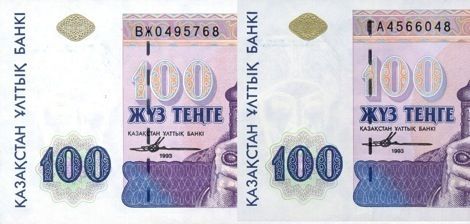
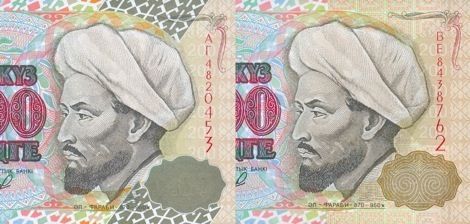

There are two different 100-tenge notes dated 1993. The original (B113a, top left) was issued in 1993. It features an intaglio rosette in the upper left corner of the front of the note. There is a second variety also dated 1993 (B113b, top right), but issued in 2001. It has the rosette in OVI.
There are two different 200-tenge notes dated 1999. The original (B119a, middle left) was issued in 2000. It features the denomination embossed on a rosette in the lower right corner of the front of the note. There is a second variety (B120a, middle right) also dated 1999, but issued in 2002. It has a latent image instead of embossing, and a different background design to the right of the portrait.
There are two different 500-tenge notes dated 1999. The original (B121a, bottom left) was issued in 2000. It features the denomination embossed on a rosette in the lower right corner of the front of the note. There is a second variety (B122a, bottom right) also dated 1999, but issued in 2002. It has a latent image instead of embossing, and a different background design to the right of the portrait.
Courtesy of Eduard Han.
